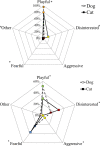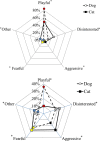Cats and dogs: Best friends or deadly enemies? What the owners of cats and dogs living in the same household think about their relationship with people and other pets
- PMID: 32845923
- PMCID: PMC7449504
- DOI: 10.1371/journal.pone.0237822
Cats and dogs: Best friends or deadly enemies? What the owners of cats and dogs living in the same household think about their relationship with people and other pets
Abstract
Although popular culture describes them as mortal enemies, more and more often, dogs and cats live under the same roof. Does this make them best friends? Can sharing the same social and physical environment make them similar? This study compares the approaches of dogs and cats living in the same household have towards humans and other pets as perceived by the owner. Questionnaires collected from 1270 people owning both dog(s) and cat(s) were analysed. Most dogs and cats living together are playful with familiar humans (76.2%) but dogs have a more sociable approach towards strangers and conspecifics than cats (P<0.001). Moreover, the percentage of dogs that have a playful relationship with the owner (84.0%) was higher than cats (49.2%; P<0.001). Dogs and cats living together eat in different places and show different mutual interactions: more dogs lick the cat (42.8%) and more cats ignore the dog (41.8%) than vice versa (P<0.001). However, most dogs and cats sleep at least occasionally (68.5%) and play together (62.4%; P<0.001). Although some body postures, such as the tail's position, are interpreted differently by the two species, the greater proportions of dogs and cats show a relaxed response to several kinds of approaches of their roommate. Our questionnaire confirms the common beliefs about the sociability of the dog and the privacy of the cat, but this does not result in continuous internal struggles. Most cohabitations are peaceful. Moreover, it is true that they speak different languages, but they seem to understand each other well and interpret each other's approaches in the right way. Thus, aspiring owners should not blindly believe popular assumptions, but both knowledge and respect for species-specific pet behaviours are essential to establish a balance in the household.
Conflict of interest statement
The authors have declared that no competing interests exist.
Figures




Similar articles
-
Survey to investigate pet ownership and attitudes to pet care in metropolitan Chicago dog and/or cat owners.Prev Vet Med. 2014 Aug 1;115(3-4):198-204. doi: 10.1016/j.prevetmed.2014.03.025. Epub 2014 Apr 4. Prev Vet Med. 2014. PMID: 24774476
-
A survey of opinions towards dog and cat management policy issues in New Zealand.N Z Vet J. 2019 Nov;67(6):315-322. doi: 10.1080/00480169.2019.1645627. Epub 2019 Aug 4. N Z Vet J. 2019. PMID: 31319780
-
Owners' view of their pets' emotions, intellect, and mutual relationship: Cats and dogs compared.Behav Processes. 2017 Aug;141(Pt 3):316-321. doi: 10.1016/j.beproc.2017.02.007. Epub 2017 Mar 4. Behav Processes. 2017. PMID: 28267573
-
Microbiota insights into pet ownership and human health.Res Vet Sci. 2024 May;171:105220. doi: 10.1016/j.rvsc.2024.105220. Epub 2024 Mar 11. Res Vet Sci. 2024. PMID: 38484448 Review.
-
The Financial Costs, Behaviour and Psychology of Obesity: A One Health Analysis.J Comp Pathol. 2017 May;156(4):310-325. doi: 10.1016/j.jcpa.2017.03.007. Epub 2017 Apr 29. J Comp Pathol. 2017. PMID: 28460796 Review.
Cited by
-
Correlation between aggression at the veterinary clinic and problem behaviors at home for cats in the USA.J Feline Med Surg. 2024 Feb;26(2):1098612X231214907. doi: 10.1177/1098612X231214907. J Feline Med Surg. 2024. PMID: 38415601 Free PMC article.
-
Introducing a Puppy to Existing Household Cat(s): Mixed Method Analysis.Animals (Basel). 2022 Sep 13;12(18):2389. doi: 10.3390/ani12182389. Animals (Basel). 2022. PMID: 36139249 Free PMC article.
-
Carbapenem resistance in critically important human pathogens isolated from companion animals: a systematic literature review.Osong Public Health Res Perspect. 2022 Dec;13(6):407-423. doi: 10.24171/j.phrp.2022.0033. Epub 2022 Dec 16. Osong Public Health Res Perspect. 2022. PMID: 36617547 Free PMC article.
-
Exploring Dog and Cat Management Practices in Multispecies Households and Their Association with the Pet-Owner Relationship.Animals (Basel). 2024 Nov 30;14(23):3465. doi: 10.3390/ani14233465. Animals (Basel). 2024. PMID: 39682430 Free PMC article.
-
Nay to Prey: Challenging the View of Horses as a "Prey" Species.Animals (Basel). 2025 Feb 22;15(5):641. doi: 10.3390/ani15050641. Animals (Basel). 2025. PMID: 40075924 Free PMC article. Review.
References
-
- Diverio S, Menchetti L, Riggio G, Azzari C, Iaboni M, Zasso R, et al. Dogs’ coping styles and dog-handler relationships influence avalanche search team performance. Appl Anim Behav Sci. 2017;191: 67–77. 10.1016/j.applanim.2017.02.005 - DOI
-
- Olsen C, Pedersen I, Bergland A, Enders-Slegers MJ, Patil G, Ihlebaek C. Effect of animal-assisted interventions on depression, agitation and quality of life in nursing home residents suffering from cognitive impairment or dementia: a cluster randomized controlled trial. Int J Geriatr Psychiatry. 2016;31: 1312–1321. 10.1002/gps.4436 - DOI - PubMed
MeSH terms
LinkOut - more resources
Full Text Sources
Miscellaneous

